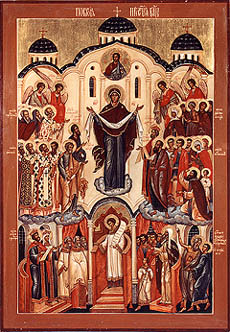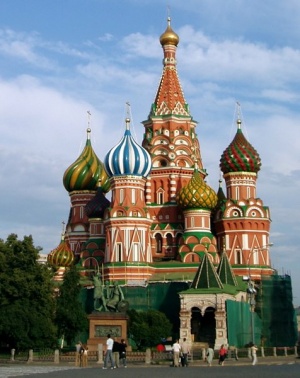Protection of the Mother of God
The Protection of the Mother of God is one of the most beloved feast days on the Orthodox calendar among the Slavic peoples, commemorated on October 1. The feast is celebrated additionally on October 28 in the Greek tradition. It is also known as the feast of the Virgin Mary's Cerement.
In most Slavic languages the word "cerement" has a dual meaning of "veil" and "protection." The Russian word Pokrov (Покров), like the Greek Skepi (Σκέπη), has a complex meaning. First of all, it refers to a cloak or shroud, but it also means protection or intercession. For this reason, the name of the feast is variously translated as the Veil of Our Lady, the Protecting Veil of the Theotokos, the Protection of the Theotokos, or the Intercession of the Theotokos.
Contents
The feast
The feast day celebrates the appearance of the Mother of God at Blachernae (Vlaherna) in the tenth century. At the end of St. Andrei (Andrew of Constantinople) Yurodivyi's life, he, with his disciple St. Epiphanius, and a group of people, saw the Mother of God, St. John the Baptist, and several other saints and angels during a vigil in the Church of Blachernae, nearby the city gates. The Blachernae Palace church was where several of her relics were kept. The relics were her robe, veil, and part of her belt that had been transferred from Palestine during the fifth century.
The Theotokos approached the center of the church, knelt down and remained in prayer for a long time. Her face was drowned in tears. Then she took her veil (cerement) off and spread it over the people as a sign of protection. During the time, the people in the city were threatened by a barbarian invasion. After the appearance of the Mother of God, the danger was averted and the city was spared from bloodshed and suffering.
Celebration of the feast
The Protection is commemorated most fervently in Slavic churches, probably because St. Andrei was a Slav. The first celebration of the Theotokos's cerement in the Russian Orthodox Church dates back from the 12th century and today is celebrated throughout the Orthodox Church.
The feast day commemorating the miracle is celebrated with an All-Night Vigil, with many of the same elements as occur on Great Feasts of the Theotokos. However, this feast has no afterfeast.
Russian usage
The Russian Primary Chronicle noted that the intercession of the Theotokos was needed for the protection of the people of Constantinople when a large fleet of the pagan Rus, led by Askole and Dir, was threatening Constantinople. The invading fleet was defeated and the event remembered. Strangely, the feast came to be considered a very important feast by the Slavic Orthodox Churches but not by the Greeks.
A twelfth century Russian chronicle describes the establishment of the intercession as a special feast day honoring the event. Within a few centuries churches began being named in honor of the Protection of the Mother of God.
Among these churches two that are world famous are: in Moscow, the Cathedral of Intercession upon a Moat (Russian: Храм Покрова "на рву," Cathedral of the Pokrov upon a moat), which is popularly known as the St. Basil's Cathedral and in Bogolyubovo near Vladimir, the Church of Intercession upon the Nerl River (Russian: Церковь Покрова на Нерли, Tserkov Pokrova na Nerli).
The Moscow cathedral was built in the mid 1500s by Tsar Ivan IV and the Bogolyubovo church was built in 1165 by Prince Andrew Bogoliusky. In Novgorod, the Monastery of the Intercession of Our Lady (Zverin Monastery) was also built during the twelfth century.
Greek usage
In recent years, the Feast of the Protection has become associated with thanksgiving for the deliverance of the Greek nation from the Italian invasion of 1940. These events are commemorated in Greece in a national holiday known as "Ochi Day" or "No Day," referring to the response of the Greek leader Metaxas to Mussolini's ultimatum.
In recognition of this, and because of the many miracles of the Holy Virgin which were reported by Greek soldiers during the Greco-Italian War of 1940-1941, the Holy Synod of the Church of Greece elected in 1952 to transfer the Feast from October 1 to October 28.[1]
The Ecumenical Patriarchate also provides for this usage in its parishes in Greece and in the Greek diaspora, and it is generally observed now throughout the Greek-speaking world. The observance includes the chanting of a Doxology incorporating hymns recognizing the Protection of the Theotokos over the Greek nation, as well as the kontakion "O Champion Leader."
About the icon
Two different events that took place four hundred years apart are combined in this one icon. Both events took place in the former Church of Blachernae in Constantinople.
The icon of the feast, Protection of the Mother of God, shows the Theotokos standing above the faithful with her arms outstretched in prayer and draped with a veil. On both sides of her are angels. On the lower right of most icons of this feast, are saints Andrew and his disciple Epiphanius who saw this vision of the Mother of God, with the twelve apostles, bishops, holy women, monks and martyrs, spreading her veil in protection over the congregation. St. Epiphanius is wearing a tunic under his cloak and gestures in astonishment at the miraculous appearance, while St. Andrew, Fool-for-Christ, is dressed only in a cloak.
Below the Theotokos, in the center of the icon, stands a young man with a halo, he is clothed in a deacon's sticharion. In his left hand, he is holding an open scroll with the text of the Kontakion for Nativity in honor of the Mother of God. This is St. Romanus the Melodist, the famous hymnographer whose feast is also celebrated on the same day, October 1. He is with his choir attended by the Emperor Leo the Wise together with the Empress and the Patriarch of Constantinople.
Hymns
- Today the faithful celebrate the feast with joy
- illumined by your coming, O Mother of God.
- Beholding your pure image we fervently cry to you:
- "Encompass us beneath the precious veil of your protection;
- deliver us from every form of evil by entreating Christ,
- your Son and our God that He may save our souls."
- Today the Virgin stands in the midst of the Church
- and with choirs of saints she invisibly prays to God for us.
- Angels and bishops worship,
- apostles and prophets rejoice together,
- since for our sake she prays to the pre-eternal God.
References
- ↑ Great Synaxaristes: (Greek) Μνήμη Ἁγίας Σκέπης τῆς Ὑπεραγίας Θεοτόκου. 28 Οκτωβρίου. ΜΕΓΑΣ ΣΥΝΑΞΑΡΙΣΤΗΣ.
Sources
- The Miracle of the Virgin Mary at the Church of Blachernae in Constantinople in 911 A.D.
- The Protection of our Most Holy Lady the Mother of God and Ever-Virgin Mary (OCA)
- Makarios, The Synaxarion: The Lives of the Saints of the Orthodox Church (Volume 1), Ormylia: 1998, pp. 249-250 [ISBN 9608560373]

